NUTR2003 Assignment: Social Determinants of Health Report
VerifiedAdded on 2022/11/24
|7
|1220
|297
Report
AI Summary
This report examines the critical relationship between cardiovascular disease (CVD) and the social determinants of health (SDOH). It begins by defining CVD, highlighting its global impact and risk factors like high blood pressure, diabetes, and lifestyle choices. The report then focuses on Australia, emphasizing increasing health inequalities related to socioeconomic disparities. The core of the report explores key SDOH, including socioeconomic status, education, social support, physical environment, access to health services, culture, and gender. Each determinant is discussed in terms of its influence on CVD prevalence and outcomes. The report concludes by summarizing the key findings, underscoring the importance of addressing SDOH to reduce CVD mortality and improve overall population health. References from various sources support the analysis.
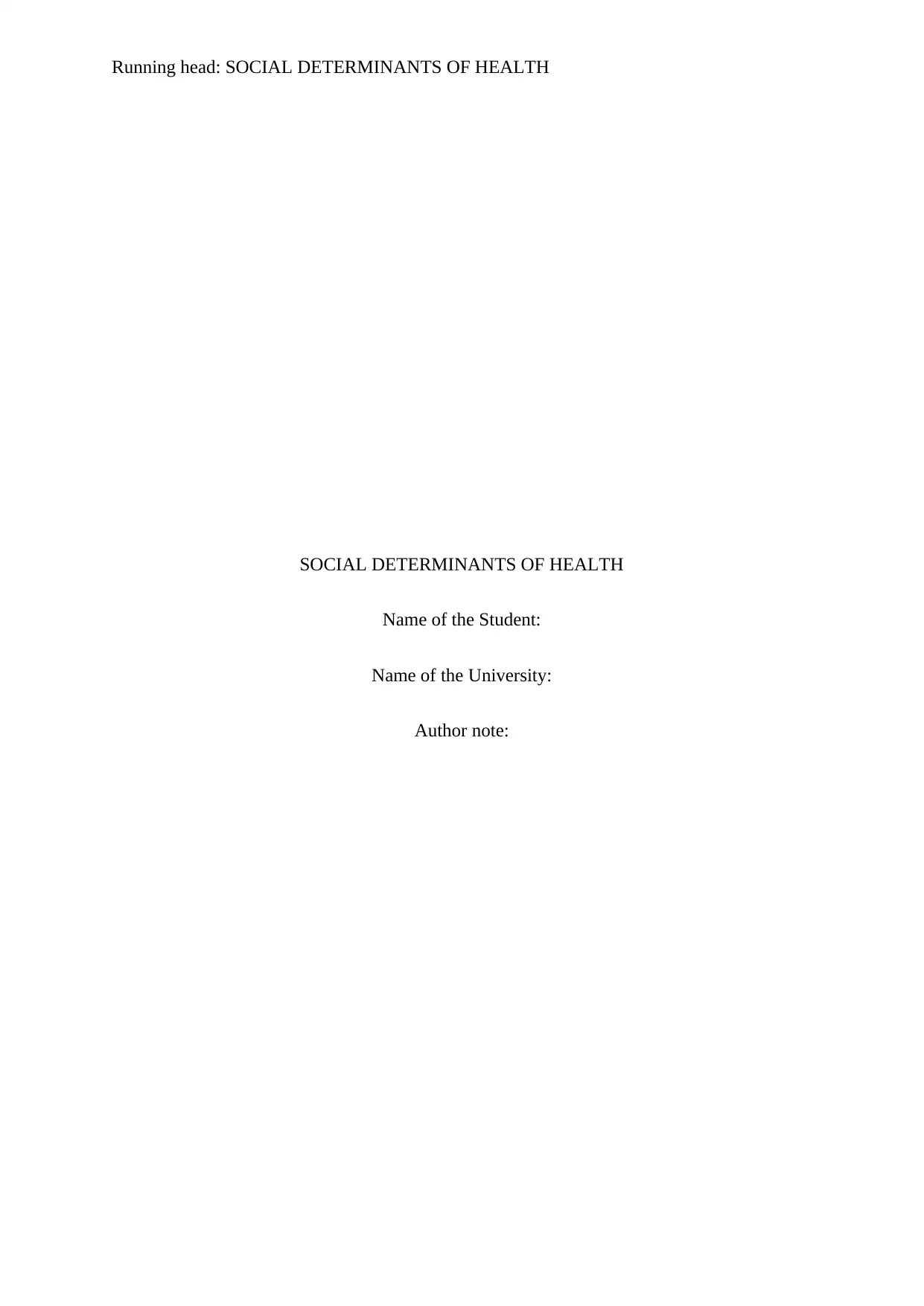
Running head: SOCIAL DETERMINANTS OF HEALTH
SOCIAL DETERMINANTS OF HEALTH
Name of the Student:
Name of the University:
Author note:
SOCIAL DETERMINANTS OF HEALTH
Name of the Student:
Name of the University:
Author note:
Paraphrase This Document
Need a fresh take? Get an instant paraphrase of this document with our AI Paraphraser
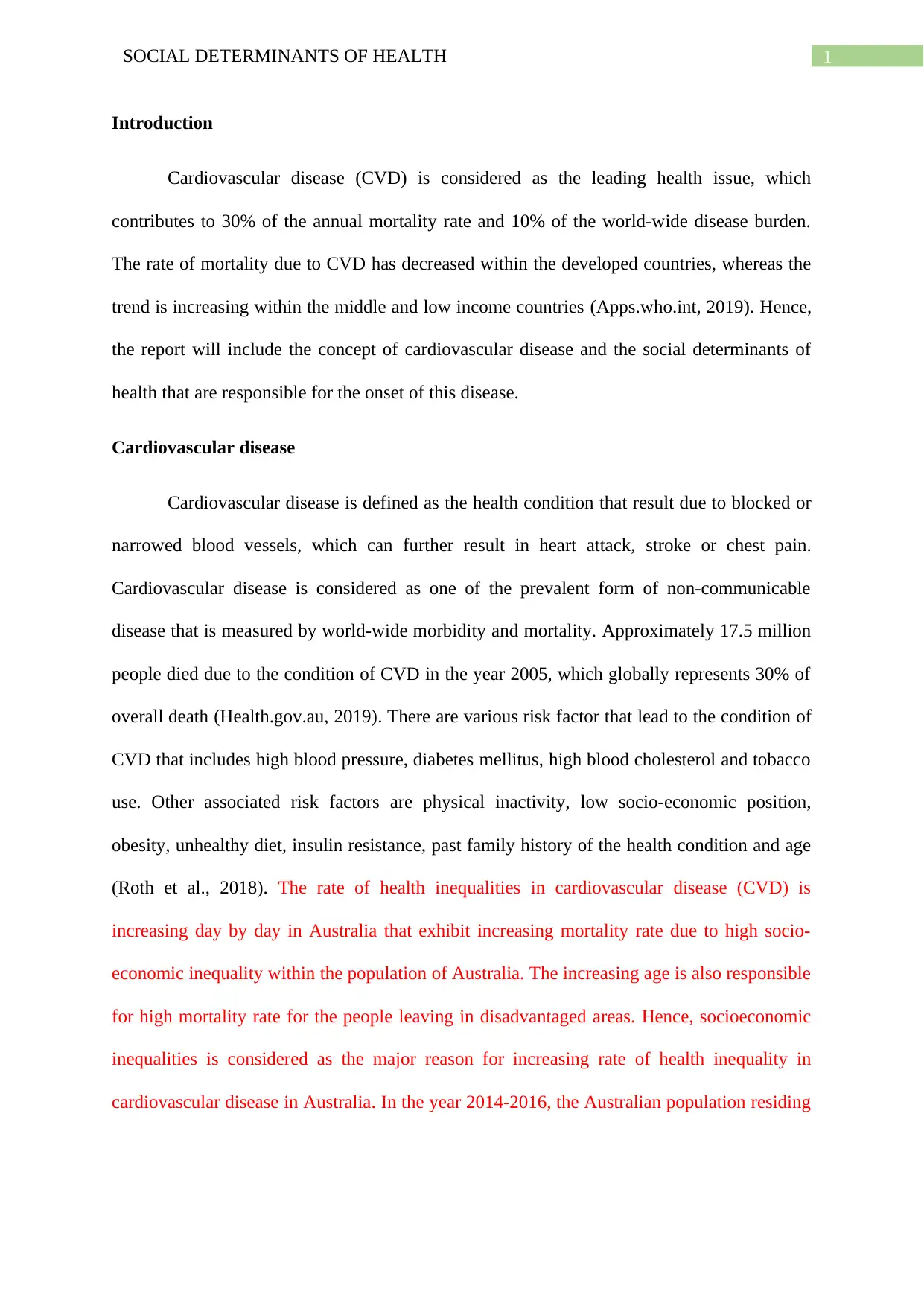
1SOCIAL DETERMINANTS OF HEALTH
Introduction
Cardiovascular disease (CVD) is considered as the leading health issue, which
contributes to 30% of the annual mortality rate and 10% of the world-wide disease burden.
The rate of mortality due to CVD has decreased within the developed countries, whereas the
trend is increasing within the middle and low income countries (Apps.who.int, 2019). Hence,
the report will include the concept of cardiovascular disease and the social determinants of
health that are responsible for the onset of this disease.
Cardiovascular disease
Cardiovascular disease is defined as the health condition that result due to blocked or
narrowed blood vessels, which can further result in heart attack, stroke or chest pain.
Cardiovascular disease is considered as one of the prevalent form of non-communicable
disease that is measured by world-wide morbidity and mortality. Approximately 17.5 million
people died due to the condition of CVD in the year 2005, which globally represents 30% of
overall death (Health.gov.au, 2019). There are various risk factor that lead to the condition of
CVD that includes high blood pressure, diabetes mellitus, high blood cholesterol and tobacco
use. Other associated risk factors are physical inactivity, low socio-economic position,
obesity, unhealthy diet, insulin resistance, past family history of the health condition and age
(Roth et al., 2018). The rate of health inequalities in cardiovascular disease (CVD) is
increasing day by day in Australia that exhibit increasing mortality rate due to high socio-
economic inequality within the population of Australia. The increasing age is also responsible
for high mortality rate for the people leaving in disadvantaged areas. Hence, socioeconomic
inequalities is considered as the major reason for increasing rate of health inequality in
cardiovascular disease in Australia. In the year 2014-2016, the Australian population residing
Introduction
Cardiovascular disease (CVD) is considered as the leading health issue, which
contributes to 30% of the annual mortality rate and 10% of the world-wide disease burden.
The rate of mortality due to CVD has decreased within the developed countries, whereas the
trend is increasing within the middle and low income countries (Apps.who.int, 2019). Hence,
the report will include the concept of cardiovascular disease and the social determinants of
health that are responsible for the onset of this disease.
Cardiovascular disease
Cardiovascular disease is defined as the health condition that result due to blocked or
narrowed blood vessels, which can further result in heart attack, stroke or chest pain.
Cardiovascular disease is considered as one of the prevalent form of non-communicable
disease that is measured by world-wide morbidity and mortality. Approximately 17.5 million
people died due to the condition of CVD in the year 2005, which globally represents 30% of
overall death (Health.gov.au, 2019). There are various risk factor that lead to the condition of
CVD that includes high blood pressure, diabetes mellitus, high blood cholesterol and tobacco
use. Other associated risk factors are physical inactivity, low socio-economic position,
obesity, unhealthy diet, insulin resistance, past family history of the health condition and age
(Roth et al., 2018). The rate of health inequalities in cardiovascular disease (CVD) is
increasing day by day in Australia that exhibit increasing mortality rate due to high socio-
economic inequality within the population of Australia. The increasing age is also responsible
for high mortality rate for the people leaving in disadvantaged areas. Hence, socioeconomic
inequalities is considered as the major reason for increasing rate of health inequality in
cardiovascular disease in Australia. In the year 2014-2016, the Australian population residing
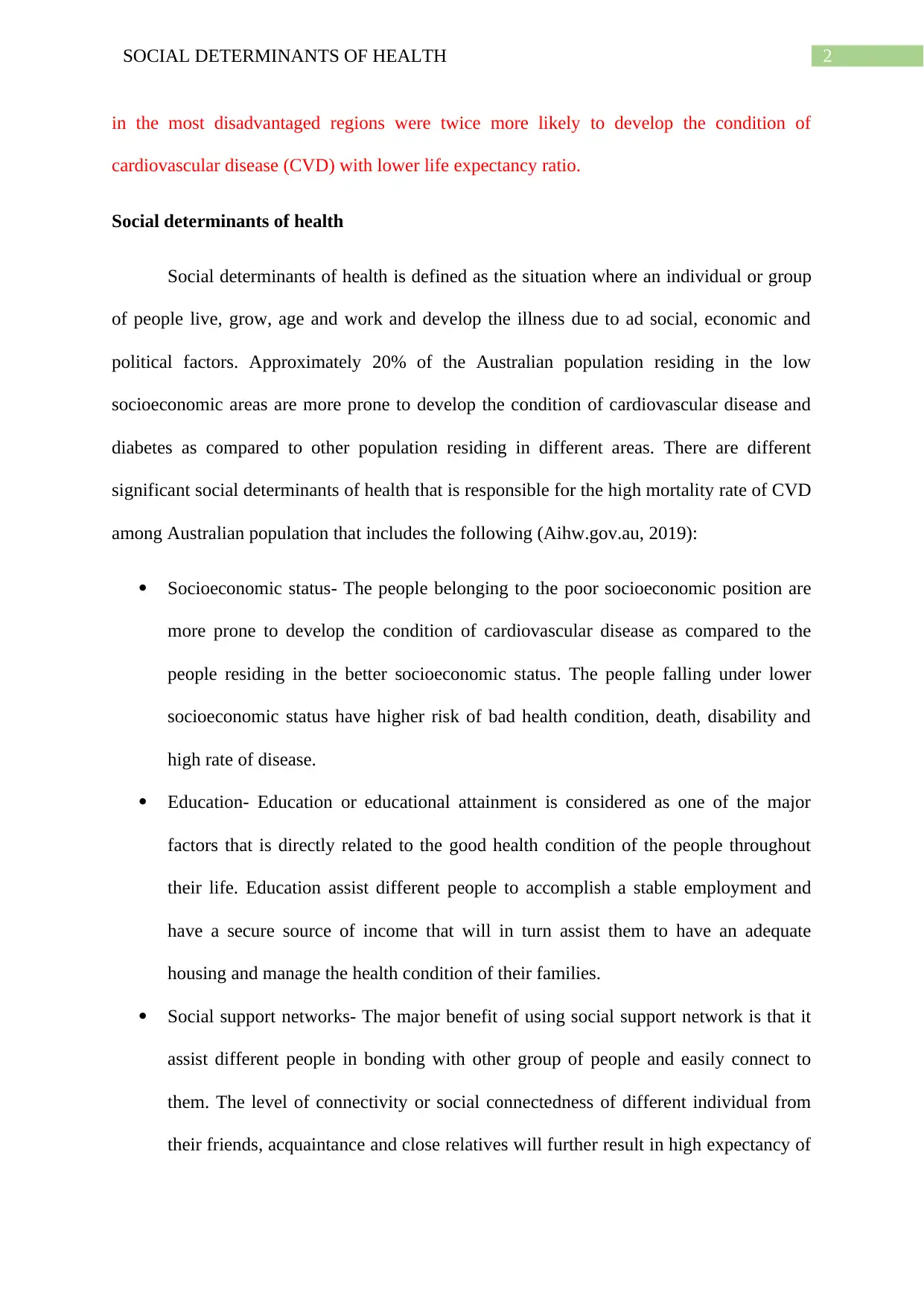
2SOCIAL DETERMINANTS OF HEALTH
in the most disadvantaged regions were twice more likely to develop the condition of
cardiovascular disease (CVD) with lower life expectancy ratio.
Social determinants of health
Social determinants of health is defined as the situation where an individual or group
of people live, grow, age and work and develop the illness due to ad social, economic and
political factors. Approximately 20% of the Australian population residing in the low
socioeconomic areas are more prone to develop the condition of cardiovascular disease and
diabetes as compared to other population residing in different areas. There are different
significant social determinants of health that is responsible for the high mortality rate of CVD
among Australian population that includes the following (Aihw.gov.au, 2019):
Socioeconomic status- The people belonging to the poor socioeconomic position are
more prone to develop the condition of cardiovascular disease as compared to the
people residing in the better socioeconomic status. The people falling under lower
socioeconomic status have higher risk of bad health condition, death, disability and
high rate of disease.
Education- Education or educational attainment is considered as one of the major
factors that is directly related to the good health condition of the people throughout
their life. Education assist different people to accomplish a stable employment and
have a secure source of income that will in turn assist them to have an adequate
housing and manage the health condition of their families.
Social support networks- The major benefit of using social support network is that it
assist different people in bonding with other group of people and easily connect to
them. The level of connectivity or social connectedness of different individual from
their friends, acquaintance and close relatives will further result in high expectancy of
in the most disadvantaged regions were twice more likely to develop the condition of
cardiovascular disease (CVD) with lower life expectancy ratio.
Social determinants of health
Social determinants of health is defined as the situation where an individual or group
of people live, grow, age and work and develop the illness due to ad social, economic and
political factors. Approximately 20% of the Australian population residing in the low
socioeconomic areas are more prone to develop the condition of cardiovascular disease and
diabetes as compared to other population residing in different areas. There are different
significant social determinants of health that is responsible for the high mortality rate of CVD
among Australian population that includes the following (Aihw.gov.au, 2019):
Socioeconomic status- The people belonging to the poor socioeconomic position are
more prone to develop the condition of cardiovascular disease as compared to the
people residing in the better socioeconomic status. The people falling under lower
socioeconomic status have higher risk of bad health condition, death, disability and
high rate of disease.
Education- Education or educational attainment is considered as one of the major
factors that is directly related to the good health condition of the people throughout
their life. Education assist different people to accomplish a stable employment and
have a secure source of income that will in turn assist them to have an adequate
housing and manage the health condition of their families.
Social support networks- The major benefit of using social support network is that it
assist different people in bonding with other group of people and easily connect to
them. The level of connectivity or social connectedness of different individual from
their friends, acquaintance and close relatives will further result in high expectancy of
⊘ This is a preview!⊘
Do you want full access?
Subscribe today to unlock all pages.

Trusted by 1+ million students worldwide
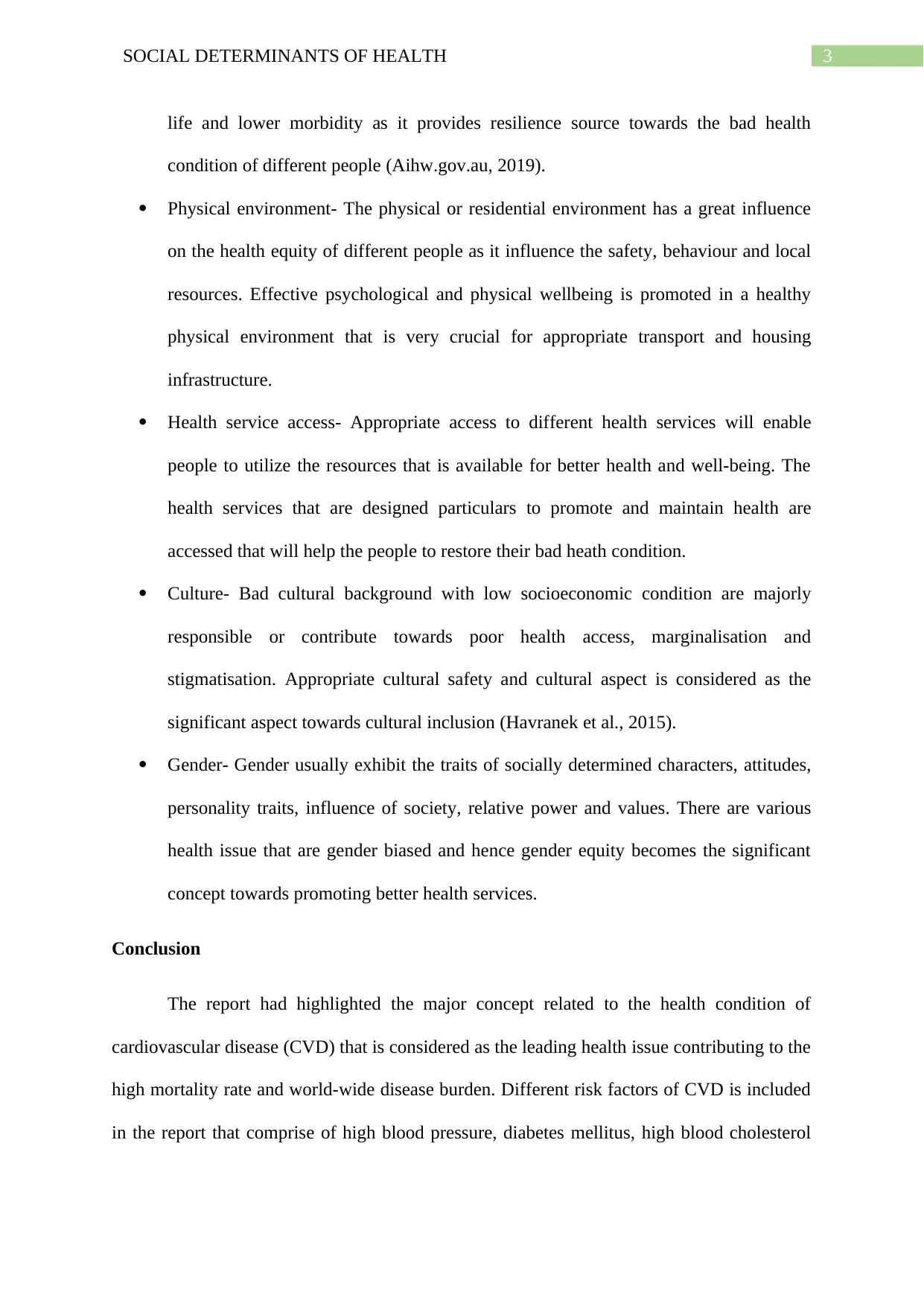
3SOCIAL DETERMINANTS OF HEALTH
life and lower morbidity as it provides resilience source towards the bad health
condition of different people (Aihw.gov.au, 2019).
Physical environment- The physical or residential environment has a great influence
on the health equity of different people as it influence the safety, behaviour and local
resources. Effective psychological and physical wellbeing is promoted in a healthy
physical environment that is very crucial for appropriate transport and housing
infrastructure.
Health service access- Appropriate access to different health services will enable
people to utilize the resources that is available for better health and well-being. The
health services that are designed particulars to promote and maintain health are
accessed that will help the people to restore their bad heath condition.
Culture- Bad cultural background with low socioeconomic condition are majorly
responsible or contribute towards poor health access, marginalisation and
stigmatisation. Appropriate cultural safety and cultural aspect is considered as the
significant aspect towards cultural inclusion (Havranek et al., 2015).
Gender- Gender usually exhibit the traits of socially determined characters, attitudes,
personality traits, influence of society, relative power and values. There are various
health issue that are gender biased and hence gender equity becomes the significant
concept towards promoting better health services.
Conclusion
The report had highlighted the major concept related to the health condition of
cardiovascular disease (CVD) that is considered as the leading health issue contributing to the
high mortality rate and world-wide disease burden. Different risk factors of CVD is included
in the report that comprise of high blood pressure, diabetes mellitus, high blood cholesterol
life and lower morbidity as it provides resilience source towards the bad health
condition of different people (Aihw.gov.au, 2019).
Physical environment- The physical or residential environment has a great influence
on the health equity of different people as it influence the safety, behaviour and local
resources. Effective psychological and physical wellbeing is promoted in a healthy
physical environment that is very crucial for appropriate transport and housing
infrastructure.
Health service access- Appropriate access to different health services will enable
people to utilize the resources that is available for better health and well-being. The
health services that are designed particulars to promote and maintain health are
accessed that will help the people to restore their bad heath condition.
Culture- Bad cultural background with low socioeconomic condition are majorly
responsible or contribute towards poor health access, marginalisation and
stigmatisation. Appropriate cultural safety and cultural aspect is considered as the
significant aspect towards cultural inclusion (Havranek et al., 2015).
Gender- Gender usually exhibit the traits of socially determined characters, attitudes,
personality traits, influence of society, relative power and values. There are various
health issue that are gender biased and hence gender equity becomes the significant
concept towards promoting better health services.
Conclusion
The report had highlighted the major concept related to the health condition of
cardiovascular disease (CVD) that is considered as the leading health issue contributing to the
high mortality rate and world-wide disease burden. Different risk factors of CVD is included
in the report that comprise of high blood pressure, diabetes mellitus, high blood cholesterol
Paraphrase This Document
Need a fresh take? Get an instant paraphrase of this document with our AI Paraphraser
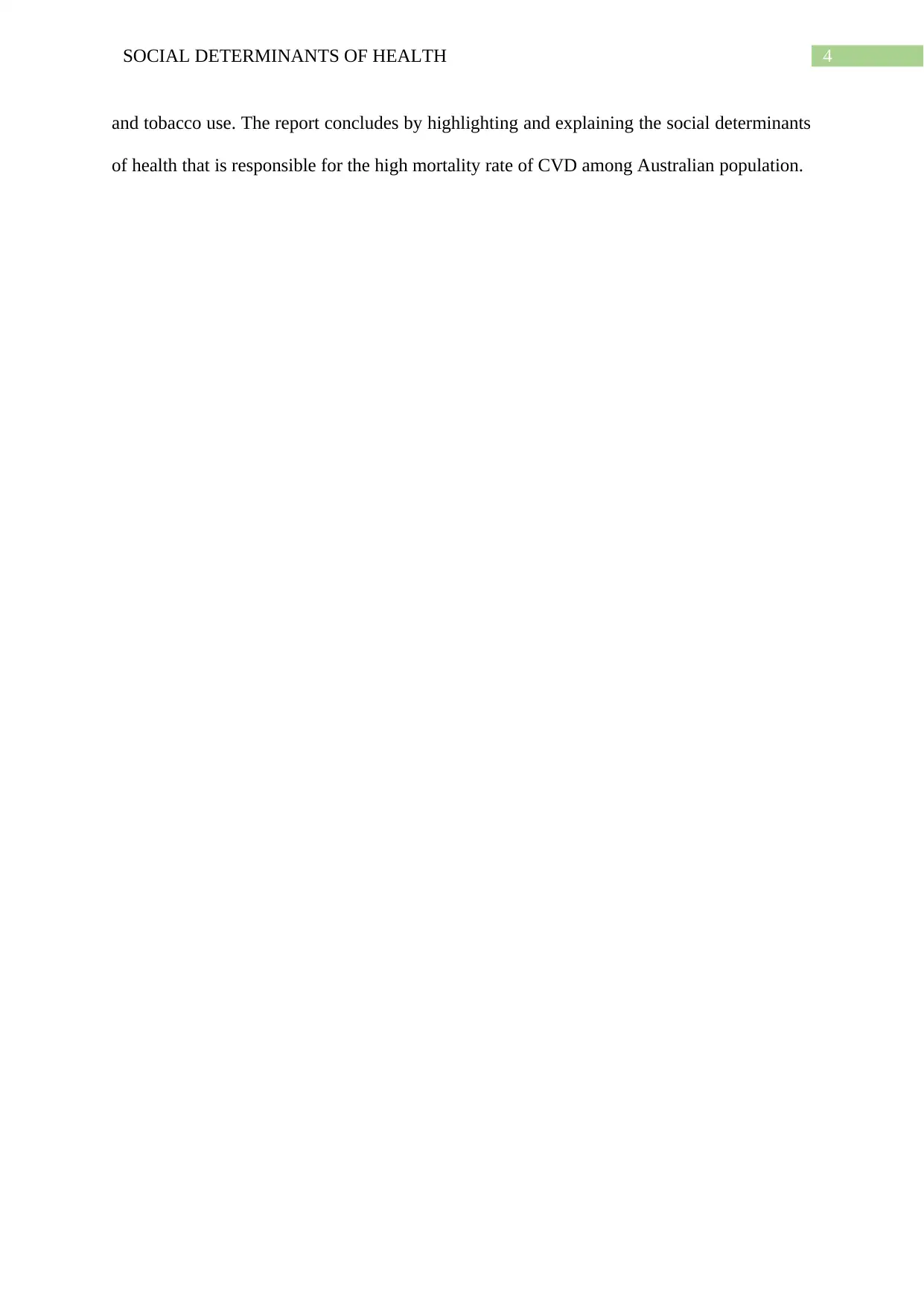
4SOCIAL DETERMINANTS OF HEALTH
and tobacco use. The report concludes by highlighting and explaining the social determinants
of health that is responsible for the high mortality rate of CVD among Australian population.
and tobacco use. The report concludes by highlighting and explaining the social determinants
of health that is responsible for the high mortality rate of CVD among Australian population.
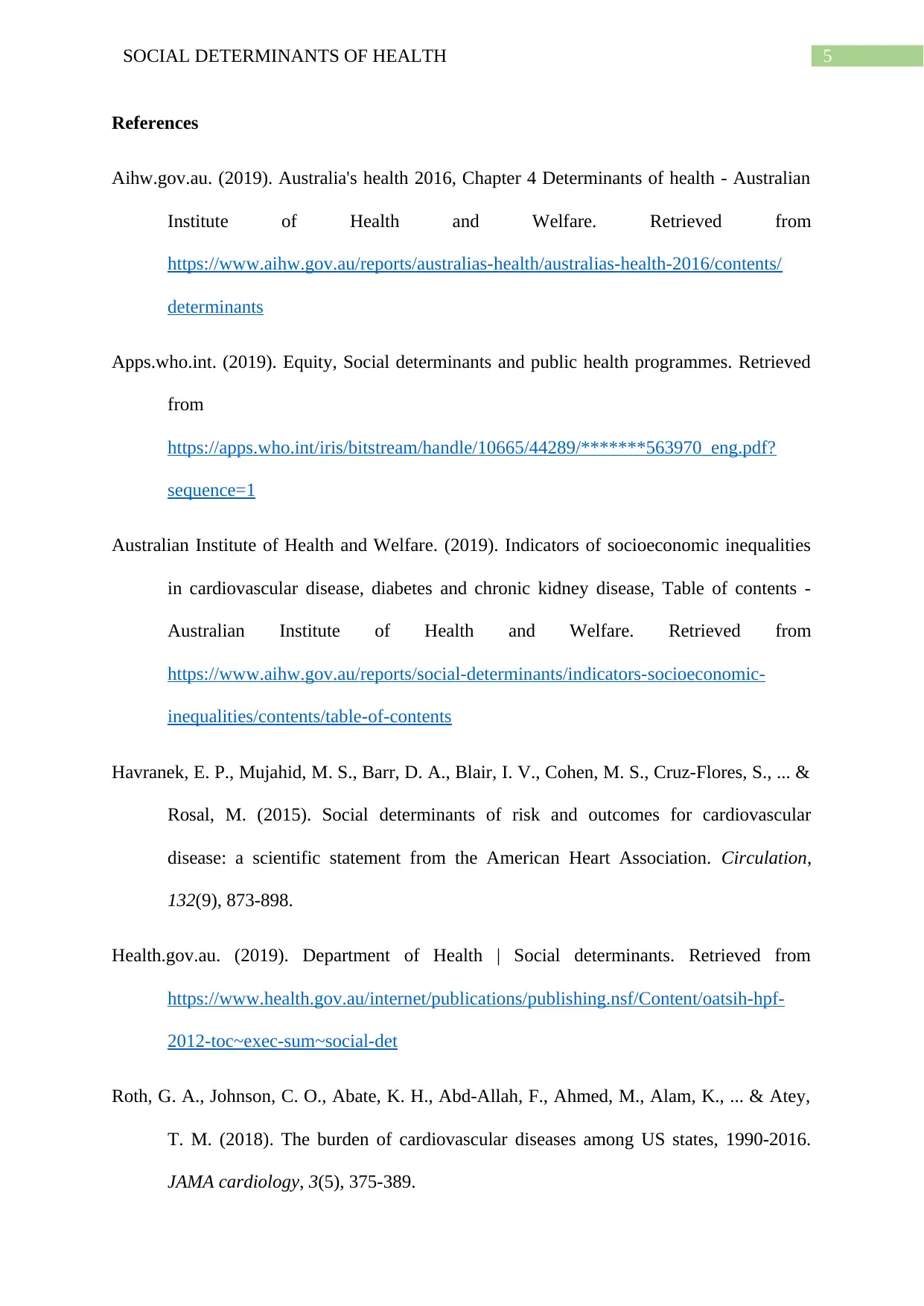
5SOCIAL DETERMINANTS OF HEALTH
References
Aihw.gov.au. (2019). Australia's health 2016, Chapter 4 Determinants of health - Australian
Institute of Health and Welfare. Retrieved from
https://www.aihw.gov.au/reports/australias-health/australias-health-2016/contents/
determinants
Apps.who.int. (2019). Equity, Social determinants and public health programmes. Retrieved
from
https://apps.who.int/iris/bitstream/handle/10665/44289/*******563970_eng.pdf?
sequence=1
Australian Institute of Health and Welfare. (2019). Indicators of socioeconomic inequalities
in cardiovascular disease, diabetes and chronic kidney disease, Table of contents -
Australian Institute of Health and Welfare. Retrieved from
https://www.aihw.gov.au/reports/social-determinants/indicators-socioeconomic-
inequalities/contents/table-of-contents
Havranek, E. P., Mujahid, M. S., Barr, D. A., Blair, I. V., Cohen, M. S., Cruz-Flores, S., ... &
Rosal, M. (2015). Social determinants of risk and outcomes for cardiovascular
disease: a scientific statement from the American Heart Association. Circulation,
132(9), 873-898.
Health.gov.au. (2019). Department of Health | Social determinants. Retrieved from
https://www.health.gov.au/internet/publications/publishing.nsf/Content/oatsih-hpf-
2012-toc~exec-sum~social-det
Roth, G. A., Johnson, C. O., Abate, K. H., Abd-Allah, F., Ahmed, M., Alam, K., ... & Atey,
T. M. (2018). The burden of cardiovascular diseases among US states, 1990-2016.
JAMA cardiology, 3(5), 375-389.
References
Aihw.gov.au. (2019). Australia's health 2016, Chapter 4 Determinants of health - Australian
Institute of Health and Welfare. Retrieved from
https://www.aihw.gov.au/reports/australias-health/australias-health-2016/contents/
determinants
Apps.who.int. (2019). Equity, Social determinants and public health programmes. Retrieved
from
https://apps.who.int/iris/bitstream/handle/10665/44289/*******563970_eng.pdf?
sequence=1
Australian Institute of Health and Welfare. (2019). Indicators of socioeconomic inequalities
in cardiovascular disease, diabetes and chronic kidney disease, Table of contents -
Australian Institute of Health and Welfare. Retrieved from
https://www.aihw.gov.au/reports/social-determinants/indicators-socioeconomic-
inequalities/contents/table-of-contents
Havranek, E. P., Mujahid, M. S., Barr, D. A., Blair, I. V., Cohen, M. S., Cruz-Flores, S., ... &
Rosal, M. (2015). Social determinants of risk and outcomes for cardiovascular
disease: a scientific statement from the American Heart Association. Circulation,
132(9), 873-898.
Health.gov.au. (2019). Department of Health | Social determinants. Retrieved from
https://www.health.gov.au/internet/publications/publishing.nsf/Content/oatsih-hpf-
2012-toc~exec-sum~social-det
Roth, G. A., Johnson, C. O., Abate, K. H., Abd-Allah, F., Ahmed, M., Alam, K., ... & Atey,
T. M. (2018). The burden of cardiovascular diseases among US states, 1990-2016.
JAMA cardiology, 3(5), 375-389.
⊘ This is a preview!⊘
Do you want full access?
Subscribe today to unlock all pages.

Trusted by 1+ million students worldwide

6SOCIAL DETERMINANTS OF HEALTH
1 out of 7
Related Documents
Your All-in-One AI-Powered Toolkit for Academic Success.
+13062052269
info@desklib.com
Available 24*7 on WhatsApp / Email
![[object Object]](/_next/static/media/star-bottom.7253800d.svg)
Unlock your academic potential
Copyright © 2020–2025 A2Z Services. All Rights Reserved. Developed and managed by ZUCOL.





